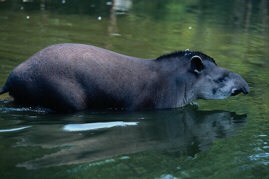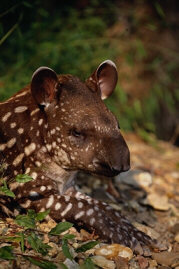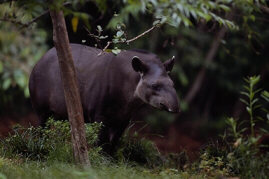Animals
Sub-Menu
|
Tapir
 The
Amazon rainforest is home to the Brazilian tapir – the largest native mammal in
Amaz⌠nia. It stands about a metre high and two metres long (similar in size to a donkey)
and resembles a bizarre cross between a pig and a rhinoceros. The animals have an
elongated head with small eyes, rounded erect ears, and small trunk-like snout which is
used for rolling up leaves and other vegetation on the ground prior to eating. An adult
tapir weighs between 150 and 250 kg. Young tapirs are coloured differently from adults
– they are dark brown, streaked with yellowish-white stripes and spots. The
Amazon rainforest is home to the Brazilian tapir – the largest native mammal in
Amaz⌠nia. It stands about a metre high and two metres long (similar in size to a donkey)
and resembles a bizarre cross between a pig and a rhinoceros. The animals have an
elongated head with small eyes, rounded erect ears, and small trunk-like snout which is
used for rolling up leaves and other vegetation on the ground prior to eating. An adult
tapir weighs between 150 and 250 kg. Young tapirs are coloured differently from adults
– they are dark brown, streaked with yellowish-white stripes and spots.
 Tapirs
are herbivores, eating a mixture of leaves, grasses, aquatic plants, tree bark, branches,
and fruit. They are solitary are rarely travel in groups. They live in the wettest parts
of the forest, and are never far from water. The are also very good swimmers. Tapirs
remain hidden in the undergrowth during the day, emerging at night to feed in grassland
and scrub. Within their territory, tapirs travel daily along the same paths –
eventually wearing a well-defined track through the forest which can then be used by
hunters when tracking the animals. Hunting tapirs is popular as a source of meat and
animal hide. It is also viewed as a sport, similar to deer and pig hunting in New Zealand. Tapirs
are herbivores, eating a mixture of leaves, grasses, aquatic plants, tree bark, branches,
and fruit. They are solitary are rarely travel in groups. They live in the wettest parts
of the forest, and are never far from water. The are also very good swimmers. Tapirs
remain hidden in the undergrowth during the day, emerging at night to feed in grassland
and scrub. Within their territory, tapirs travel daily along the same paths –
eventually wearing a well-defined track through the forest which can then be used by
hunters when tracking the animals. Hunting tapirs is popular as a source of meat and
animal hide. It is also viewed as a sport, similar to deer and pig hunting in New Zealand.
Unfortunately, continued hunting and destruction of the tapir's natural environment
have led to a decline in the tapir's numbers. As a result, tapirs now appear on the
endangered species list. Two close relatives of the Brazilian tapir, the Central American
(Baird's) tapir and the Andean mountain tapir, are now both on the edge of extinction.
However, there is a glimmer of hope in that tapirs have been described as being easily
domesticated – meaning that it may one day be possible to raise tapirs on farms
instead of hunting them in the wild.

|